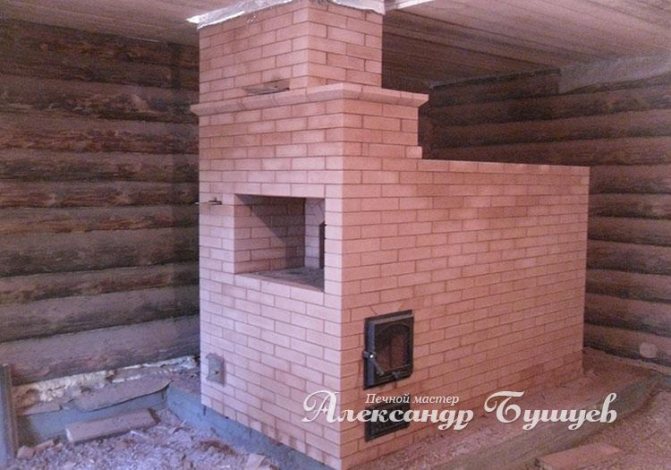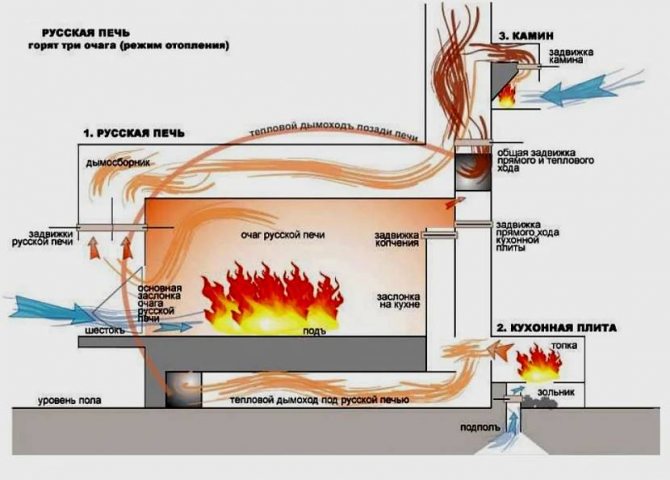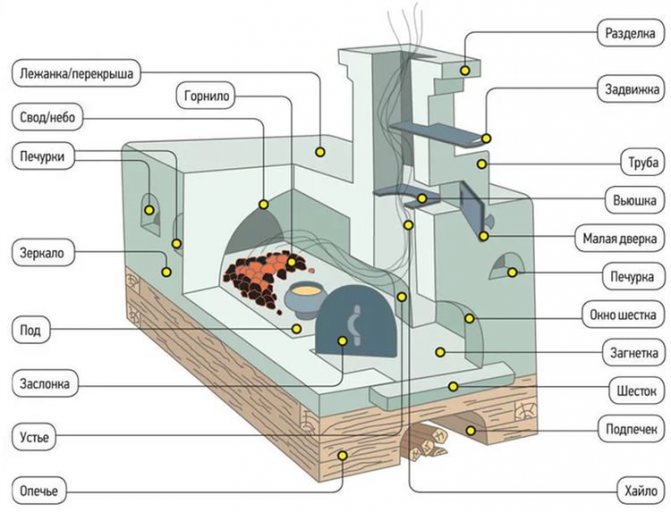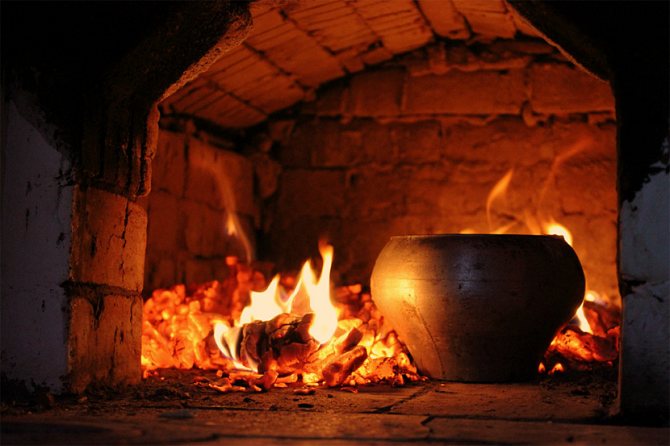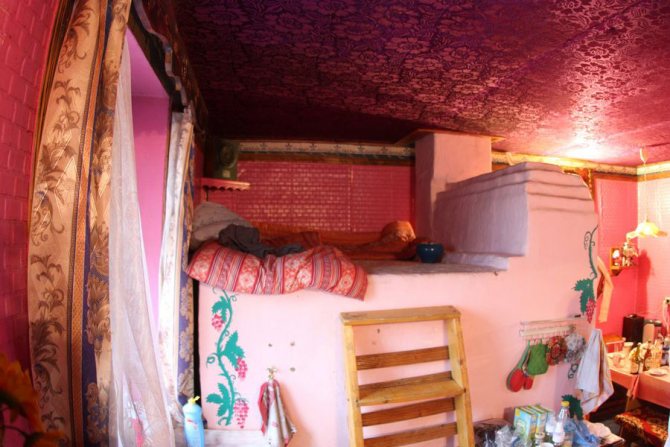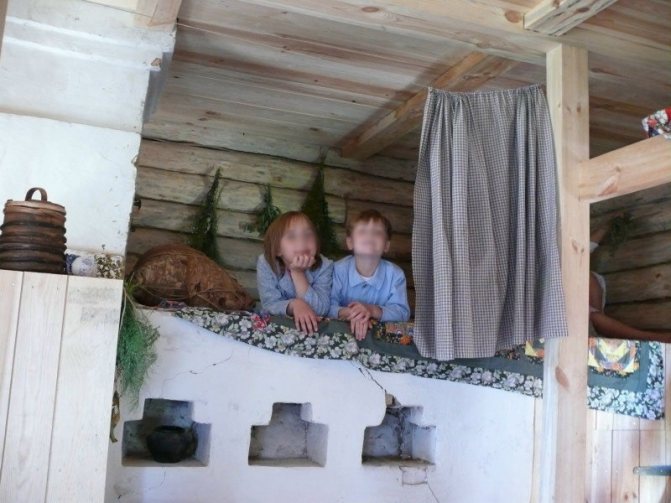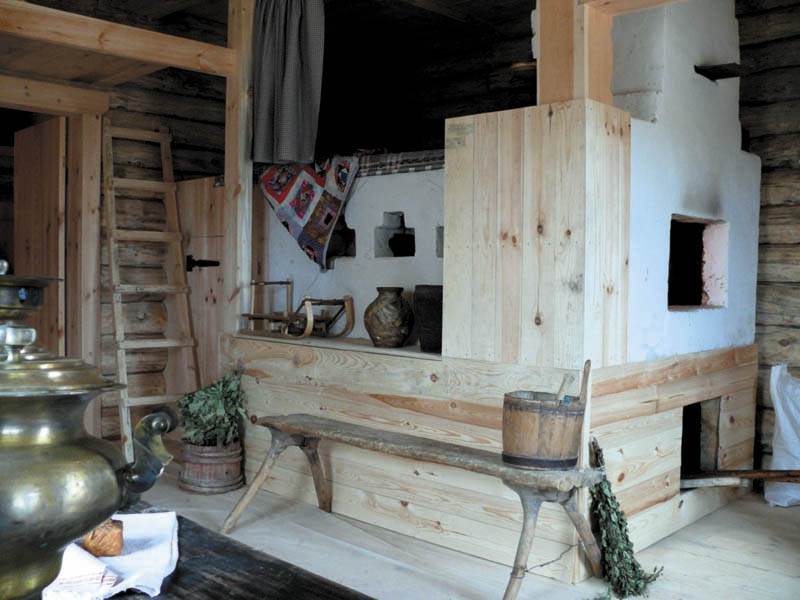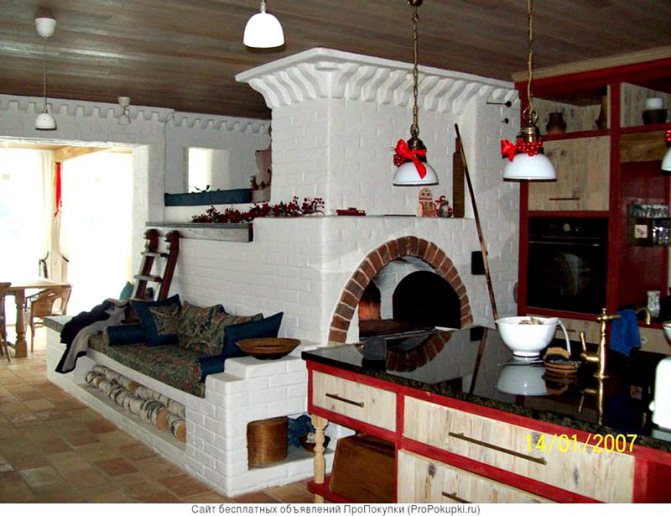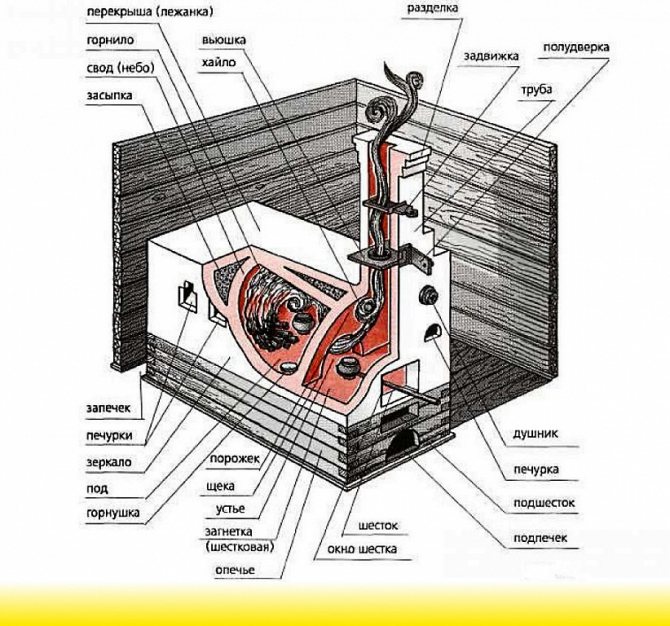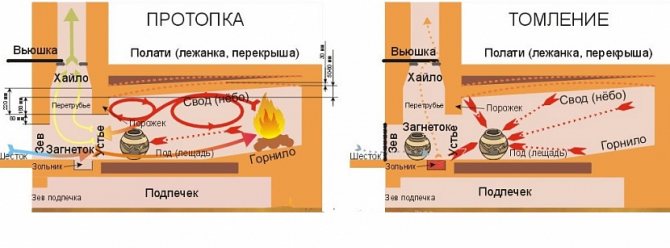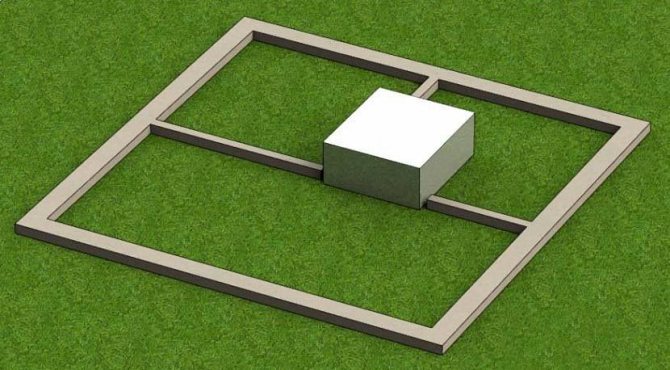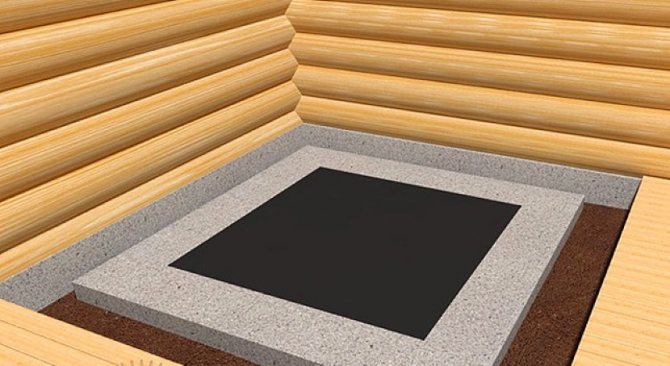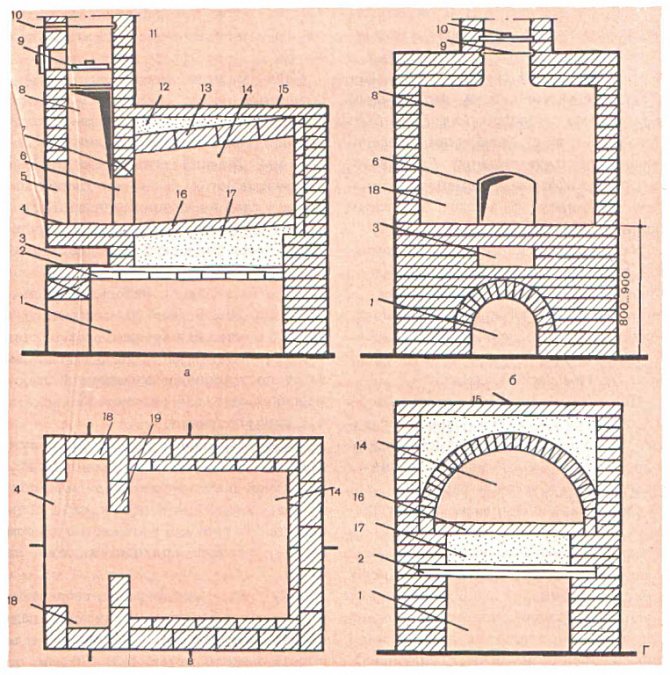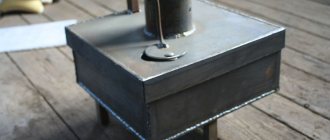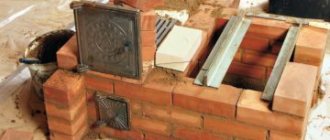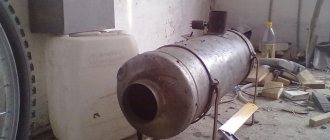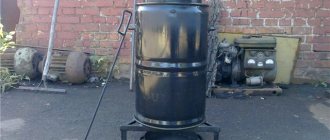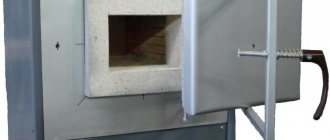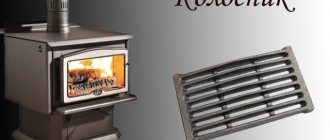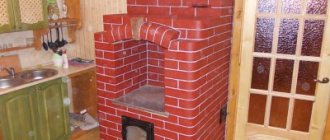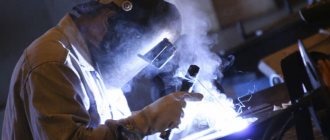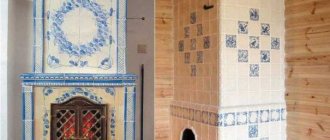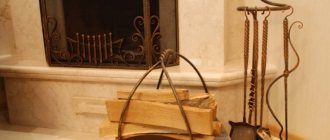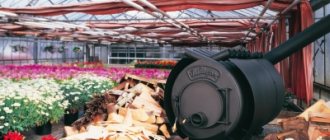Section with the ordering of Russian stoves and heating units.
Russian stoves, the most famous stove designs. They serve both for heating the room and for cooking food. The main feature of the stove is the arched vault of the Russian stove chamber. It is not easy to do, it takes a lot of preparation. Usually the arched vault is covered with sand and a couple of rows of bricks are laid. Thus, a full-fledged bed is obtained. Nowadays, there are different variations of stoves. You can make a Russian stove with a flood and a stove. You can add an oven and heat shields on both sides. As in the case with heating stoves, it is possible to lay the coil in the heating chamber underflooding. In this section, you can find designs of famous stove-makers - Podgorodnikov, Kuznetsov.
Ordering the Russian stove
considered one of the most difficult. It is necessary to correctly design all the channels and necessarily the operating modes of the furnace. Traditional
Russian stove
-large combustion chamber located at the level of the belt. The movement is based on the cap type.
When did masonry Russian stove
, usually attached a flood with a hob. Thus, the space under the Russian stove could now be made permeated with heating channels, thereby increasing the efficiency of the stove.
Having bought the project of the Russian stove
, you will see that the ordering comes in two views, isometric and parallel projection, the latter is very convenient for accurately determining the size of the brick.
Many stove-makers
they do not know how to lay Russian stoves due to the complexity of the construction of the vault. The vault is made either with arched bricks or by sawing it.
A special place in Russian stove
is occupied by a bed, this is a characteristic attribute only
Russian stove
... Before putting
Russian stove
, you need to develop the correct project with the location of all the elements of the Russian stove and the placement of the chambers. When
oven masonry
be sure to use
services of a stove-maker
Russian stove - Teplushka 2
I. S. Podgorodnikov with minor changes
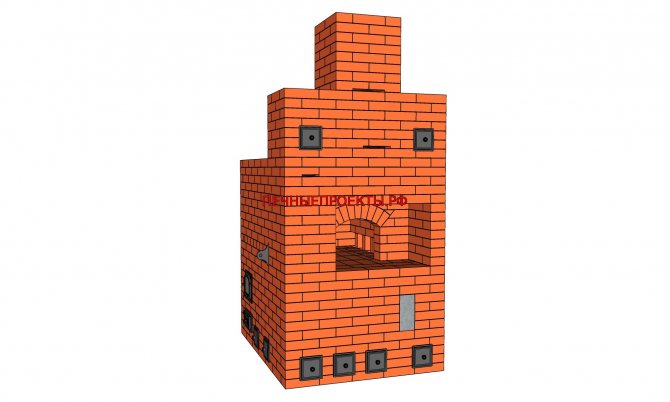
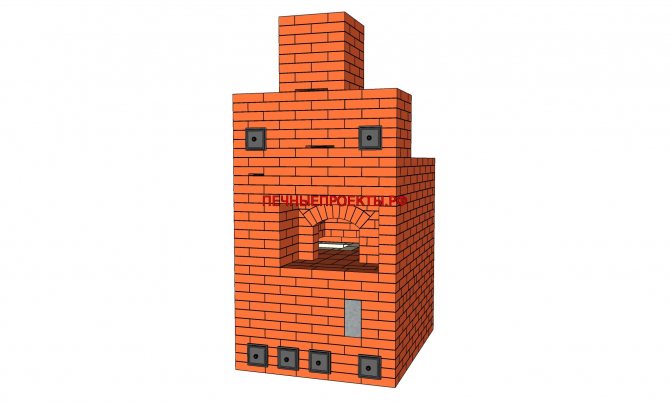

- Dimensions: 1660mm * 1280mm
- Cooking chamber dimensions: 770mm * 890mm
- Heated room: 50 sq.m.
- Number of bricks: 1250pcs
- Operating modes:
- -Summer
- -Winter
- -Russian stove
- Gas flow diagram: SDG
Podgorodnikov heating device
This design consists of two tiers. The lower one provides 80% of the heat, the upper one absorbs about twenty. The firebox of the improved Russian stove is possible in one of two ways:
- The first, traditional option, is to melt the fire in a crucible, that is, in a large furnace. Stoves have been heated in this way for many centuries. Before preparing food, you need to heat the stove, collect the coals, and then put them on under the dishes with food.
- The second method can be implemented in closed fireboxes with a grate. A hob is placed on top of the firebox. This model differs in that the plate acts as a shelf located in front of the crucible.
The gas outlet of the device is designed in such a way that warm air always enters the lower part of the furnace, warming up its body. If the structure is heated from a large firebox, the stove will also heat up. This model allows you to increase heat transfer and save fuel. The view after the firebox should not be closed very tightly - it is necessary to leave the draft so that the cooled gases do not begin to enter the room.
Russian stove
Oven with 5 channels, firebox and hob
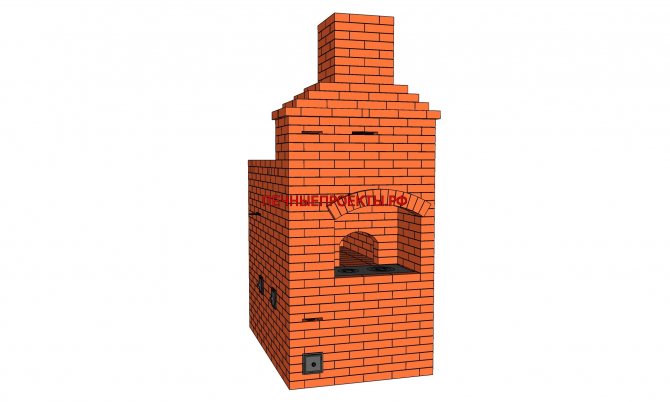

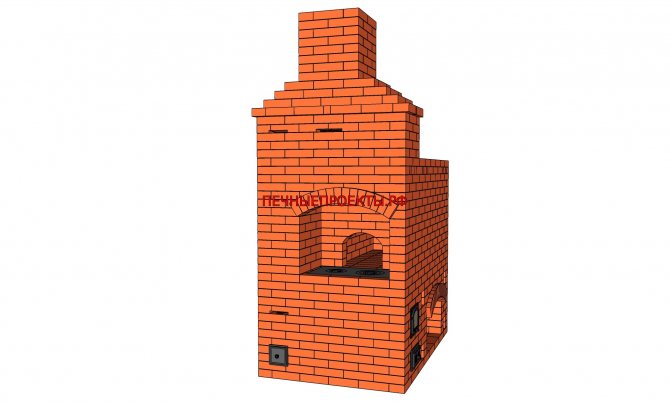

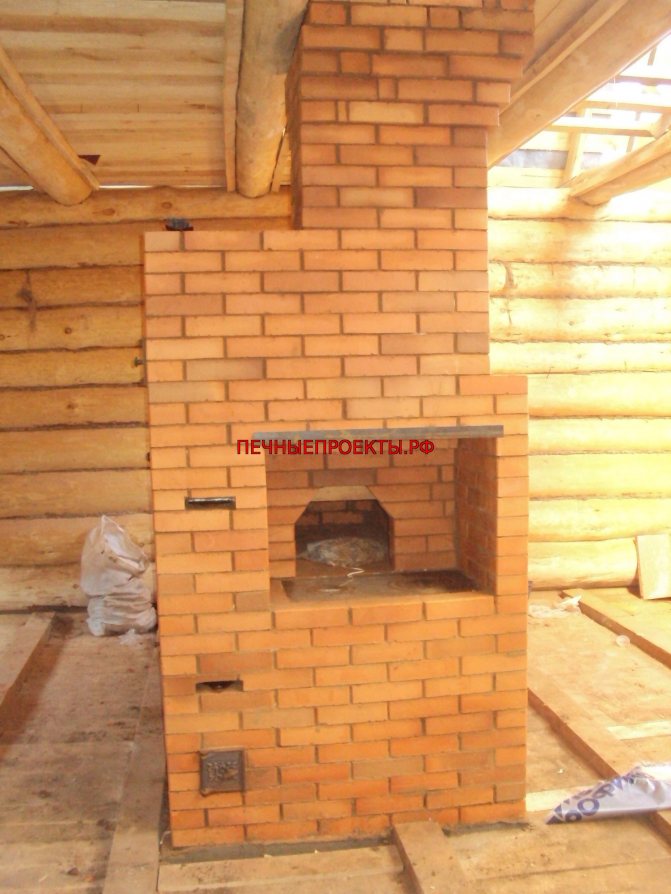

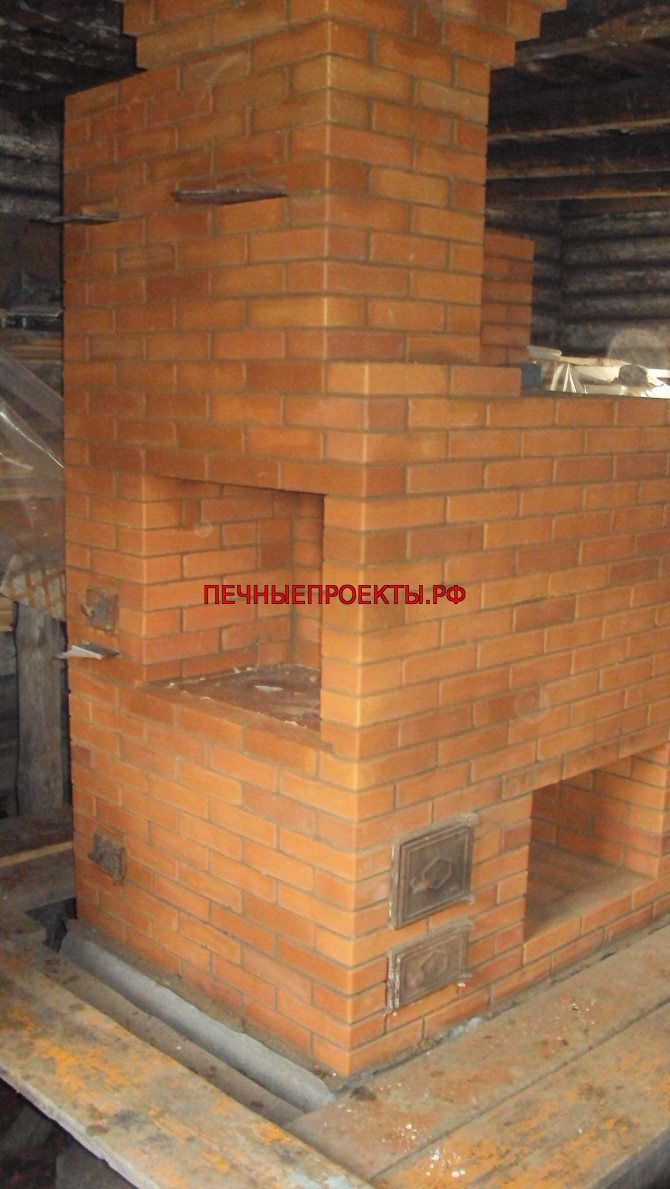

- Dimensions: 1270mm * 2040mm
- Heated room: 45 sq.m.
- Number of bricks: 1650pcs
- Operating modes: Summer (only stove), Winter (5 channels, bed, or their combination)
- Gas flow diagram: channel
Russian stove 2
Stove with stove bench, for cooking food
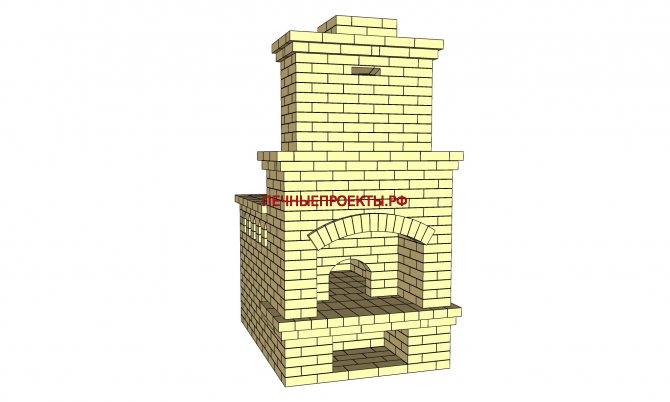

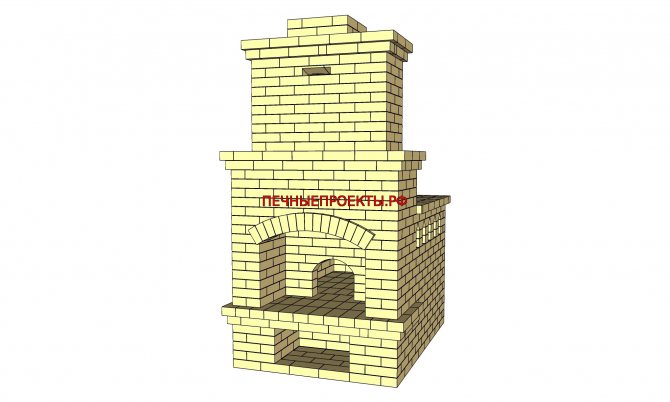

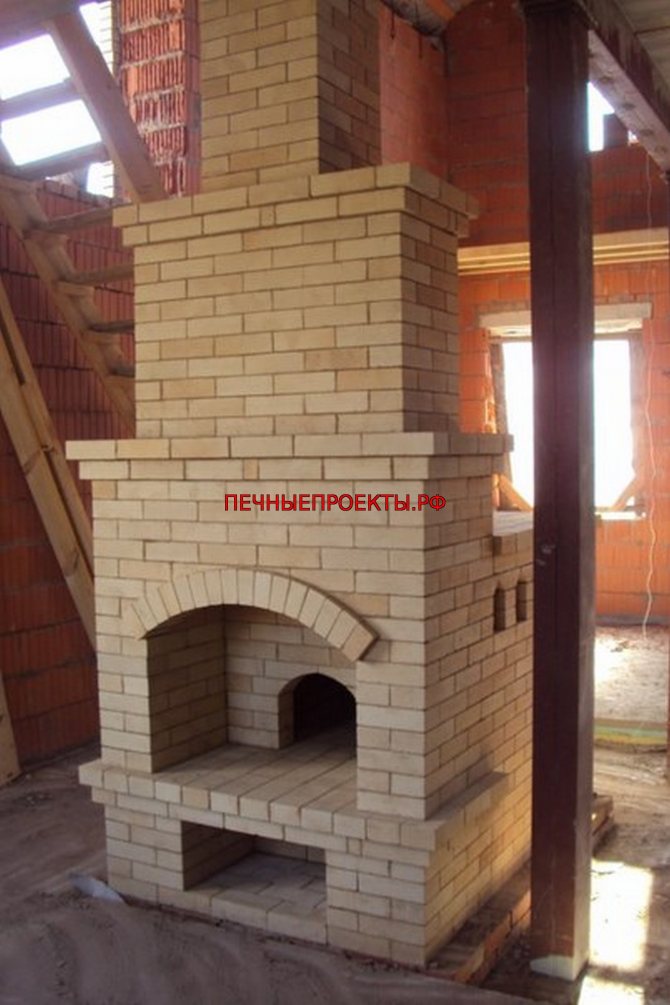

- Dimensions: 1280mm * 1860mm
- Cooking chamber dimensions: 1060mm * 820mm
- Heated room: up to 35 sq.m.
- Number of bricks: 1350pcs
The teplushka stove comes from Russia
The Russian stove, the design of which has been improved, is a heating stove. Making a laying of such a stove on your own is a fascinating business. But it should be carried out based on the drawings of Podgorodnikov: it was he who developed and improved the first generations of heating devices.
The first improved oven models had their drawbacks. These could be cracks on the side or back wall as a result of severe overheating. When the vault heats up, a Russian stove, when it rises from the heat, begins to press on the sidewalls and slightly pushes them apart. This flaw did not bring unpleasant consequences, but it was eradicated with the improvement of this model of the stove.
Differences between the heating furnace
The Podgorodnikov heating stove differs from the usual Russian stove in its size, which allows it to be erected in a room of any size (it does not take up much space). The stove not only warms up the lower part of the room, but also heats up quickly, within half an hour, and you can cook on it right away, without waiting for the wood to burn out in the crucible.
The Podgorodnikov stove is designed not only for firewood, but also for another type of fuel. There are several dozen different designs of these ovens, but the # 171; Teplushka-15 # 187; oven can be called the most successful.
Materials required for work
To build a furnace, not only building materials are needed, but also metal fittings:
- Firebox door. Dimensions 25x21 in the amount of 1.
- The door for the furnace with dimensions 25x14 in the amount of 3.
- Grizzly bar for plate 25x25 # 8212; one.
- Floor grating, grate 30x25 # 8212; 2.
- View # 8212; one.
- Gate valve for summer # 8212; one.
- Ventilation valve # 8212; one.
- Crucible damper 40x32 # 8212; one.
- Cooking stove for two burners 71x41 # 8212; one.
- Water heating box # 8212; one.
Building material for the Podgorodnikov teplushka furnace:
The teplushka stove has dimensions of 1 m 29 cm x 1 m 29 cm. The height inherent in stoves is 32 rows of bricks, that is, 2 m 24 cm. Such an improved Russian stove can heat a 35 m² room.
The core of the Podgorodnikov furnace is made on a ready-made dry mortar # 171; Plitonite # 187; which is refractory. The orders of the kiln are made on a clay-cement mixture, which is kneaded from cement, clay and sand in a ratio of 1: 2: 7.
Description of the oven masonry
The Podgorodnikov heating stove is constructed according to the principle of a familiar stove. The stove has dampers for smoke circulation. You can operate the hob in the summer separately from the firebox.
Order of the Podgorodnikov furnace:
- The 1st order is made of solid bricks, the front sides are being erected. The middle part of the kiln is made with divided bricks and quarters.
- 2nd order. It is necessary to perform a dressing and put a blower door, which is fixed with masonry. An ash pan is inserted opposite.
- Next two rows. The ash pan (blown) is fenced off with a wall of one brick. A jumper is arranged on top. The corner is rounded inside the channel.
- On the 5th row, a heel and formwork are arranged for the erection of the arch. On this vault there will be a backfill on which it is laid under.
- On the 6th and 7th rows, walls are being erected, the canal is blocked. The overlap should be with multiple holes. They are intended for vertical ducts. The space that remains must be filled with clay mortar.
Stages of laying the Podgorodnikov furnace
Next row. The edges of the bricks that were laid above the blowers are chipped away. So, a surface with a slope will be obtained. We mount the grate, you should put it with side gaps. The grate should be free.
- In the 9th row, the doors are fixed. The channels are built according to the scheme. In order for the fuel to roll onto the grate, bricks are chipped behind the firebox.
- In the 10th row, we complete the overlap of the water heating box, backfill is made near the back wall, which becomes the bottom of the hearth.
- Next, the usual laying of the walls of the Podgorodnikov furnace is carried out. The back side of the cooking chamber is laid out. Corners are attached so that the masonry does not deform. The cleaning overlap is done.
- Starting from row 13, the cooking chamber is being erected. On the 16th row is laying. The brick must be laid on the edge along the side walls of the Podgorodnikov furnace. The brick is laid with a slope inward. This can be achieved with thin brick wedges.
- The 17th row completes the construction of the cooking chamber. In the middle, a brick is chipped off along the side walls of the chamber. To install the vault, formwork is made, the laying is carried out from both sides at the same time. If the formwork fits snugly in the middle of the cooking chamber, it can be disassembled or burned.
Further, everything is being built strictly according to the scheme. If it's hard to figure it out yourself, you can turn to an experienced stove-maker for help.
Now there are a lot of different drawings, and they all offer Podgorodnikov's furnaces. But the heating stove has many designs, so it is very difficult to choose. Here you cannot do without the help of a professional.
Summarizing
Stoves are the heart of the house: it is so cozy to sit next to them on winter evenings with your family. Therefore, even now, when technologies are constantly developing, they do not forget about stoves. In private houses, country cottages, there is always a place for a stove or fireplace. One cannot but mention the food cooked in the oven. What could be tastier and more aromatic than porridge from the oven in a cast-iron pot or fresh fragrant bread? This stove is a tribute to our ancestors, their ability to arrange their life with comfort, to make the house cozy. By the way, you can arrange a stove with a stove bench. which will perform not only decorative, but also medicinal functions. Experienced stove-makers arrange benches with adjustable heating, which creates additional comfort for a person.
The teplushka stove is great for small spaces due to its small size. Even a novice kiln master can build it, the main thing # 8212; be able to read drawings. The necessary material is sold in specialized stores or bases, this also applies to clay. We need a trowel and containers in which the solution will be mixed. It is best to grind bricks at different angles with a grinder.
Before you start building the furnace yourself, all the masters advise you to make a layout and check it in operation. If everything is functioning correctly, proceed with the construction of a stove, which you can then be proud of.
vip-ochag.ru
Russian stove 3
Oven with 5 and 10 channels, hob and bed
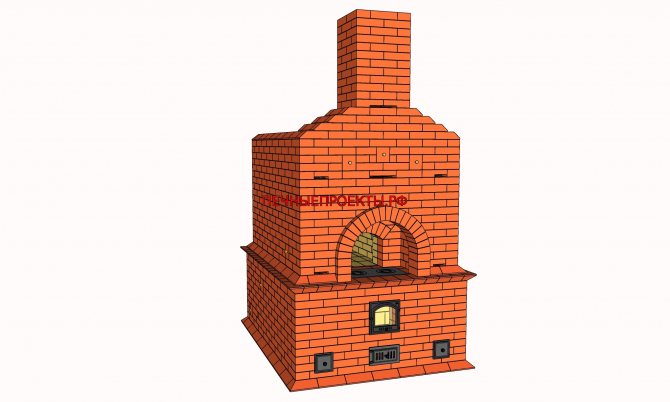

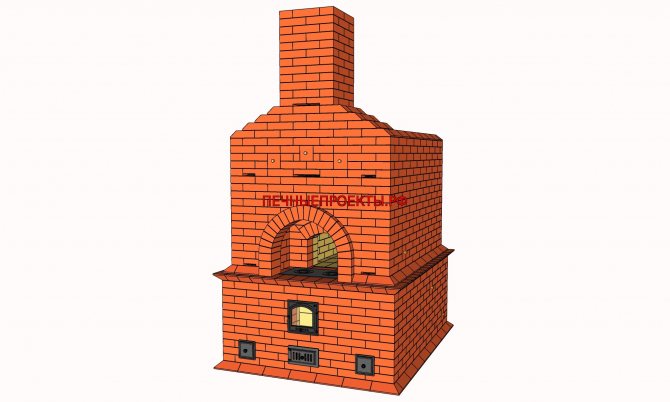

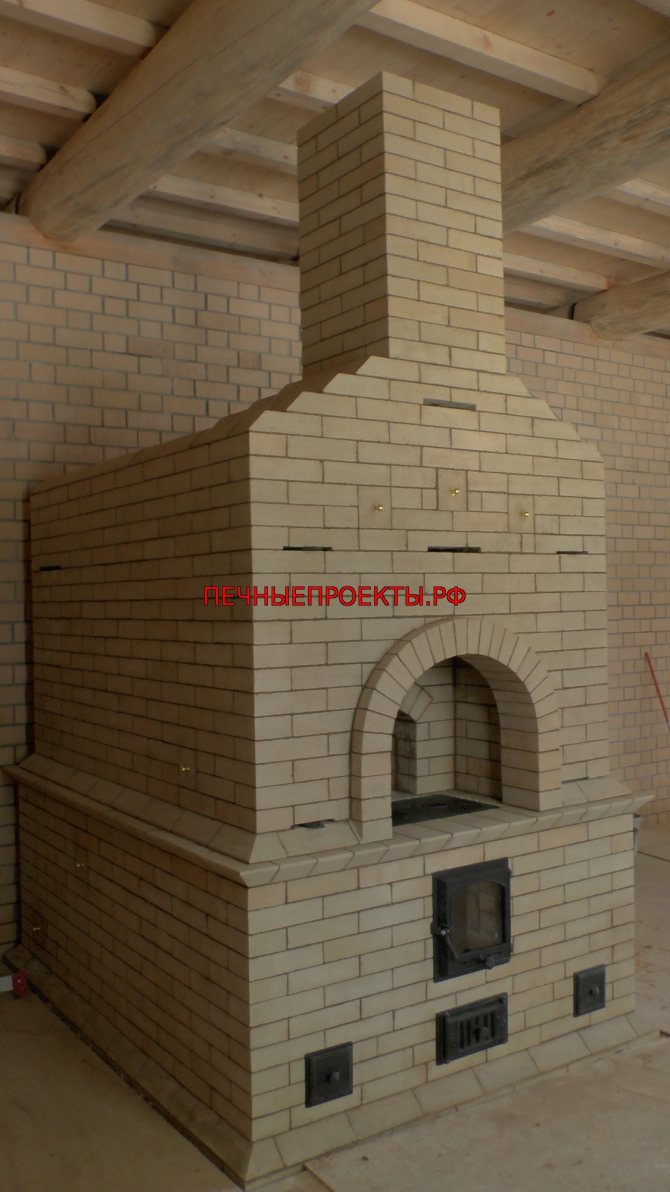

- Dimensions: 1800mm * 2300mm
- Cooking chamber dimensions: 1070mm * 510mm
- Heated room: up to 100 sq.m.
- Number of bricks: 2820pcs
- Operating modes:
- -Summer (only stove)
- -Left shield (5 channels), right shield (5 channels), them together
- -Russian stove
- -Bedbed
- - Shields, stove bench, Russian stove
- Gas flow diagram: channel
Stove with stove bench - Russian classic
It is impossible to imagine a Russian stove without a stove bench - it seems somehow too compact, modern and unusual. But the structure on which Emelya moved fully corresponds to the idea of a Russian person about a classic village stove.
Today, large and comfortable structures on which you can "warm the bones" are varied both in shape and design. Here are some samples that you can make yourself if you want:
Image gallery
Photo from
Using traditional finishes
Unfinished red brick
Painting with folk ornaments and patterns
Ceramic tiles or tiles
Such a variety of design is dictated by the desire of the owners to decorate the interior and make it unique.
Brief description of the design
Many do not know how to properly build a Russian stove with a stove bench, because they do not know either the basic elements or the details of the masonry.
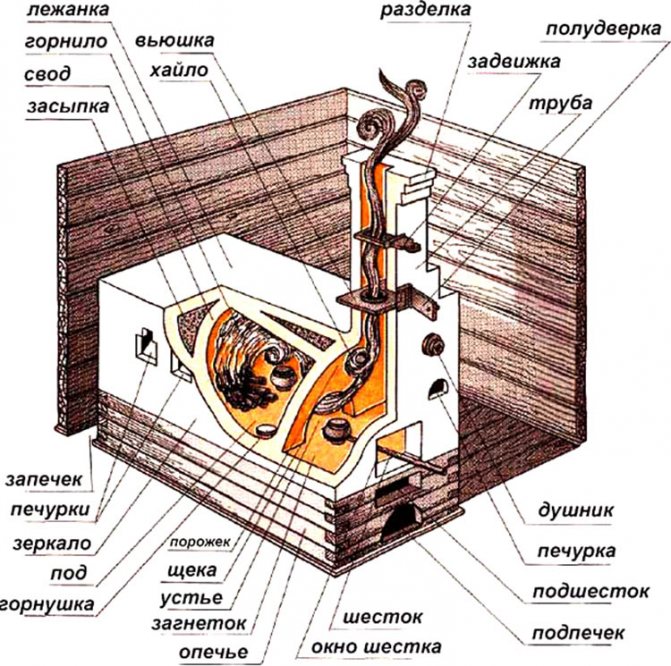

The main elements that must be present in every design. The part names may differ in different regions (for example, baking - baking)
Crucible - the main, large chamber, which serves both for storing firewood and for baking pies. The upper part of the furnace - the vault - heats up and transfers heat to the stove bench.
In front of the crucible is six - a small compartment where it is convenient to put baking sheets and pots. Here, manipulations are carried out on laying firewood on a shovel. Sometimes there is a small niche under the six - subset.
Estuary - hole leading to the furnace.
Under - an important part of the crucible, its lower plane, slightly inclined towards the mouth. Smoothest sanded oven surface.
Underpants - a niche under the oven, which serves for drying logs, storing large utensils, grabs, shovels, panicles.
Overtube - a chamber between the crucible and the pipe, located above the pole.
Vyushka - a damper that closes the chimney after the firewood burns out.
Lounger - large horizontal surface for resting or drying.
Samovar - the hole into which the samovar pipe was previously inserted.
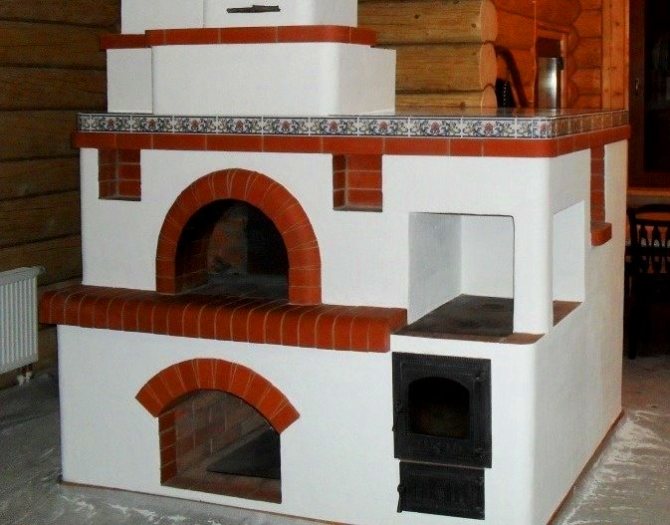

Often, a smaller structure with a cast-iron stove is attached to a large furnace. It can be heated in summer to prepare lunch.
If additional heating of the house or outbuildings (verandas) is required, a hot water boiler is built into the furnace body and wiring is made to the required premises.
Pros and cons of construction
The Russian stove has a lot of advantages over modern heating devices, so it is still popular, especially in country houses and dachas.
Advantages of the structure:
- profitability - if you build a furnace with a complex design, then the efficiency reaches 70-80%;
- low cost of materials and work of stove-makers;
- some models are heated not only with wood, but also with other types of solid fuel;
- multifunctionality - heating, cooking, complete rest;
- requires attention once a day;
- has a beneficial effect on health with dry heat from bricks.
If the building rules are followed, then safety is guaranteed.
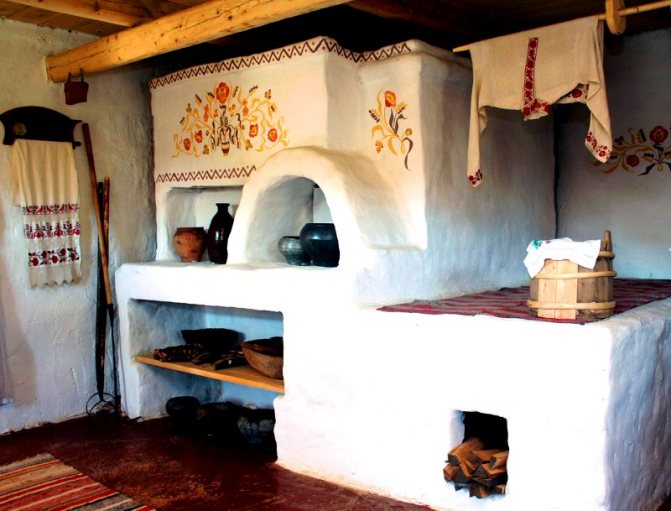

A brick structure usually lasts at least 30 years. Structures built by craftsmen live much longer - 100 or more years without major repairs
But there are also disadvantages due to which building owners refuse to install a stove. Fuel must be procured in advance, dried and taken away. Modern electric and solid fuel boilers operate more efficiently, while taking up less space and do not require constant attention.
A Russian stove can be installed only in a separate private house; it is not suitable for heating multi-apartment, and even more so multi-storey buildings.
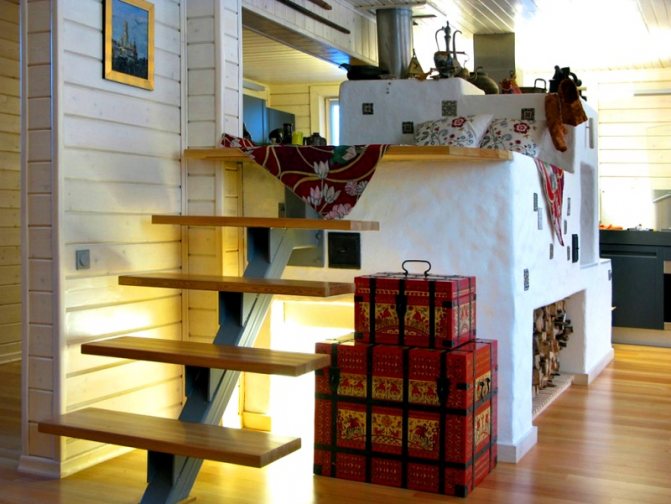

Before calculating and folding a Russian stove with a stove bench, it is imperative to determine its dimensions and installation location. Get ready for the construction to take up a lot of space
The disadvantages include regular cleaning of the furnace from ash and soot.
Russian stove 4
Oven with hob and glass door
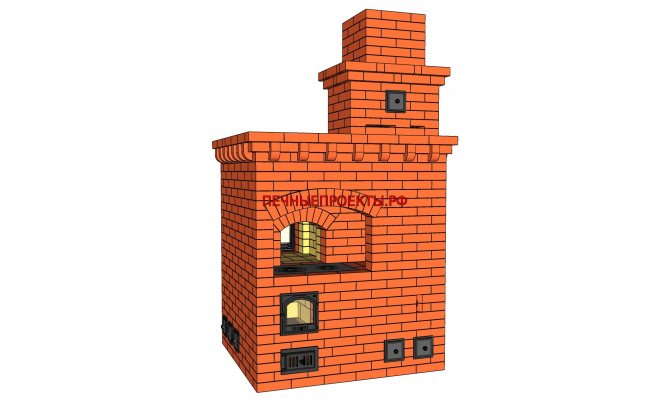

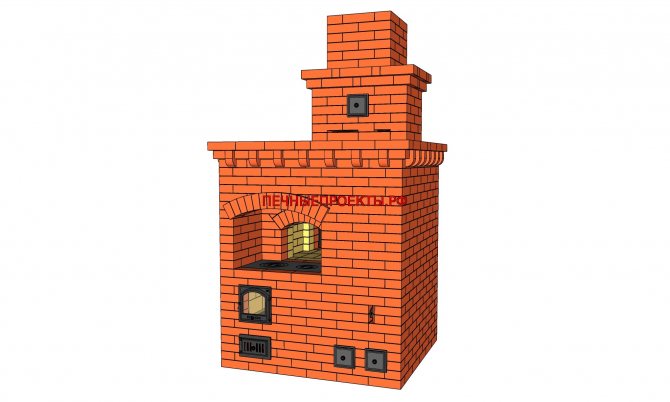

- Dimensions: 1530mm * 1400mm
- Cooking chamber dimensions: 370mm * 500mm
- Heated room: up to 60 sq.m.
- Number of bricks: 1540pcs
- Operating modes:
- -Summer (only stove)
- -Winter
- -Russian stove
- Gas flow pattern: combined
Materials for making
The body and lining of the stove from the outside are made of refractory bricks. The surface of contact with fire is covered with basalt cardboard. If it is possible to process bricks using longitudinal cuts, you can take fireclay bricks.
Despite the high temperature in the lower chamber, special heat-resistant materials are not needed here. To protect the device from cracks, the bottom of the device can be placed in a metal case.
The laying of the Podgorodnikov stove is carried out using a solution of sand and clay. The dosage is determined depending on the fat content of the clay. The easiest option is to buy a ready-made mixture for oven work.
It is worth taking care of the purchase of metal parts in advance: a hob, furnace doors, views and latches. It is advisable to choose cast iron - they increase the level of heat transfer.
Russian stove 5
Russian stove with fireplace
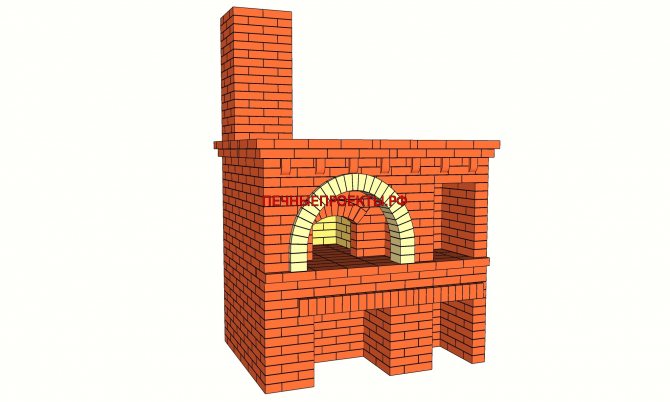

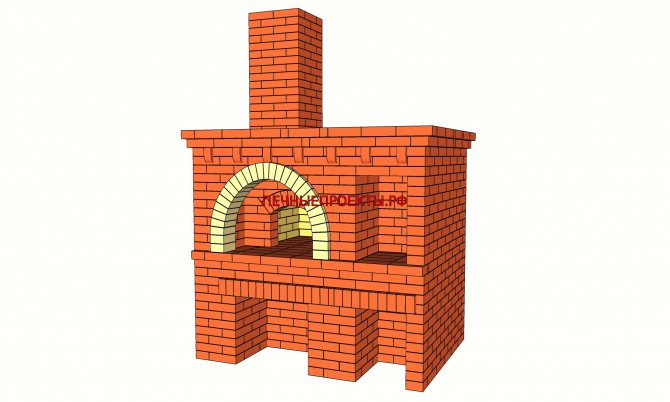

- Dimensions: 1910mm * 1400mm
- Cooking chamber dimensions: 770mm * 510mm
- Heated room: up to 35 sq.m.
- Number of bricks: 1700pcs
- Operating modes:
- -Fireplace open
- -Fireplace closed
- -Russian stove
- Gas flow pattern: combined
Russian stove 6
Russian stove with hob
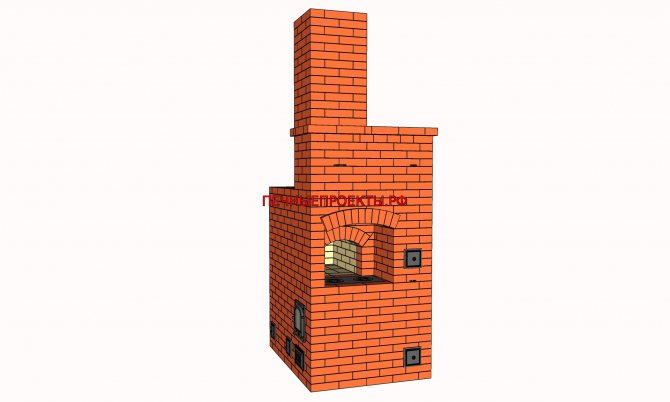

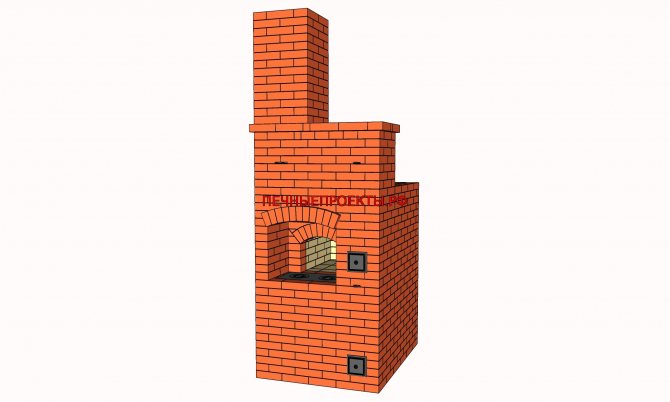

- Dimensions: 1530mm * 1150mm
- Heated room: up to 40 sq.m.
- Cooking chamber dimensions: 700mm * 380mm
- Number of bricks: 1200pcs
Varieties of construction
By design, the units are divided into two types:
- Traditional - with a bake (lower part) that does not lend itself to heating, so it can be made of any material, including wood.
- Superior (modern) with channels in the baking oven, which allows it to warm up well. Often supplemented with a hob, oven, fireplace.
Modern designs have the following dimensions:
- from 230 x 150 cm (large);
- 175 x 150 cm (medium);
- up to 175 x 150 cm (small).
In addition, they can be erected both indoors and outdoors.
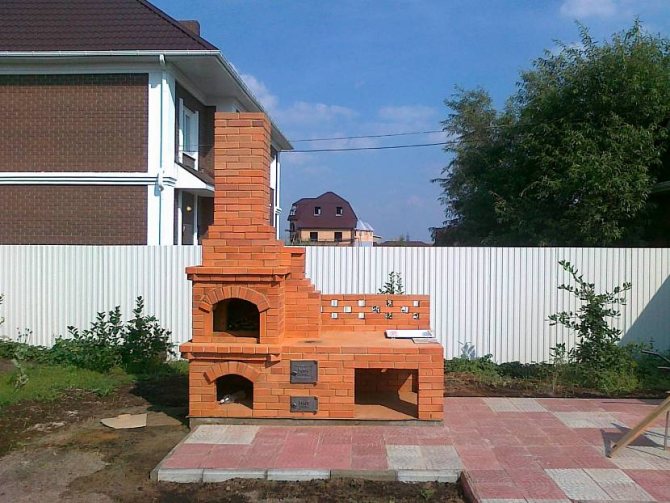

A lightweight version of the Russian stove with a foundation on the site is used for cooking, the stove bench is used as a table Source mobilizacia.kiev.ua
See also: Catalog of companies that specialize in the installation of fireplaces and stoves, extensions to ready-made houses
Also, designs can be of different geometries (shape of a pole, presence or absence of cornices) and finishes (brick, tiles or plaster). The most popular, judging by public opinion polls, is the improved version according to Podgorodnikov with a two-burner stove. In second place is "Housekeeper" - often due to a lack of floor space. In the traditional design, the bottom did not heat up, but, as you know, warm air rises upward, it was cold in the lower part of the hut, the lower rims of the house froze through and could rot. Podgorodnikov also suggested making a brick with a system of channels.
Type 1 - simple
It takes up little space, heats the house well, consists of a cooking chamber, a furnace and a pipe. The presence of a two-burner stove allows you to quickly prepare food. For such a design you will need:
- solid bricks - 1620 pcs.;
- solution - 72 buckets;
- samovar;
- plate;
- damper;
- 2 latches.
This is considered an ideal option for a small country house of 32 sq. m. You can make a flood for additional heating of the lower zone in the floor area.
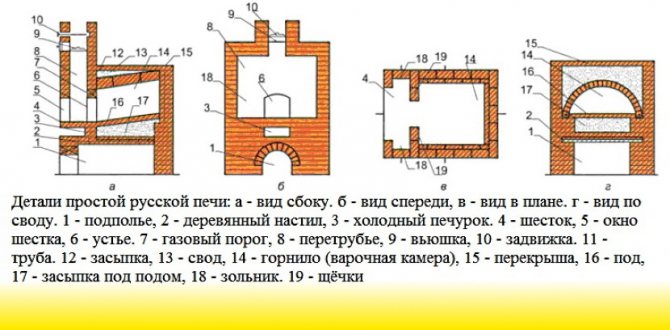

The structure of a simple type stove Source fireplace.su
To increase the effect of heat transfer, separate chimneys are installed near the walls of floods. You can also make a flood in the pole, equipping it with a stove for the fastest cooking.
Type 2 - adobe
Perhaps the cheapest way to build a Russian stove with your own hands. Here, brick is needed only for the pipe and hearth, the rest is clay mortar. For a medium-sized Russian stove, it will need about 3.5 cubic meters. The correctness of the consistency is checked in this way: they form a brick, put it on a stick perpendicularly - if the edges do not bend and the shape is preserved, then the density is necessary.
The process is as follows:
- the sand-clay mixture is laid out on a flat surface with a layer of 15 cm;
- the top is carefully aligned;
- fragments are cut from the resulting layer in the form of bricks.
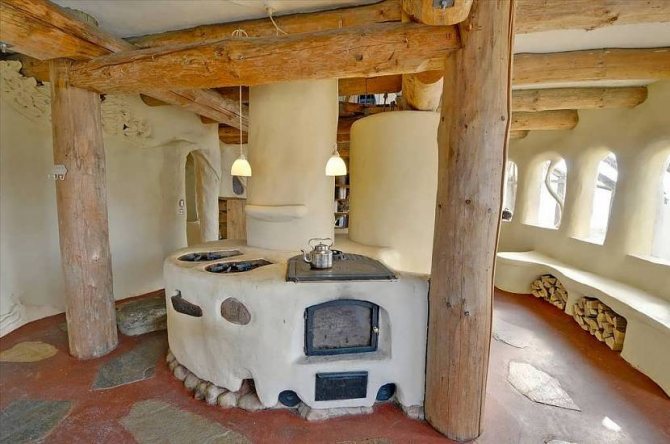

A modern version of a clay oven in a round adobe house
Bricks are usually made 20-25 cm wide, then laying is carried out, while homemade elements are knocked out and leveled, removing excess clay with a scraper. Be sure to use a level to check the vertical and horizontal.A common mistake when laying on your own is wetting the bottom row with water - this leads to a weakening of the solution and the appearance of cracks. If a break in work is required, then the last row should be covered with damp rags.
The clay oven needs to be dried for 7-8 days, after which they begin to slowly heat it with dry wood. In this case, the clay will release steam and acquire the desired structure. After 5 days with daily heating, the structure will be ready for full use.
Type 3 - "teplushka"
In terms of dimensions, these stoves can vary significantly, but they are united by the fact that the room is heated evenly from floor to ceiling along the entire height. The surface of the "teplushka" is almost 2.5 times the outer volume of a simple type.
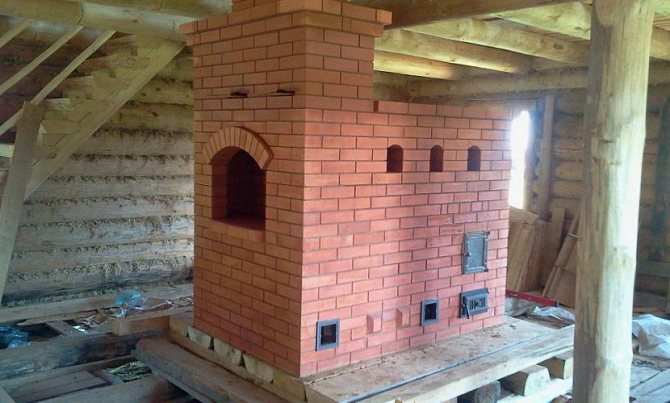

Russian stove "teplushka" with a large heating surface Source msk-kamin.ru
This oven has many advantages over other types:
- less fuel is required;
- in addition to firewood, you can also heat it with coal;
- cooking is relatively fast (30-60 minutes), it can be kept warm for up to a day, and you can start cooking even after the firewood has burned out, since the heat remains enough.
The design includes the following elements:
- the cooking chamber (upper) is located at the level of the hearth;
- heating chamber (lower) - in the oven, under the hearth.
Before folding a Russian brick stove with your own hands for a house with a stove, you should not cross out this option - the model "teplushka-4" provides for the installation of a stove in a pole. Its dimensions are 120 x 120 cm, for "teplushka-2" they are 168 x 129 cm, there is no stove in it, but there is a small hot water boiler.
Russian stove 7
Russian stove with fireplace
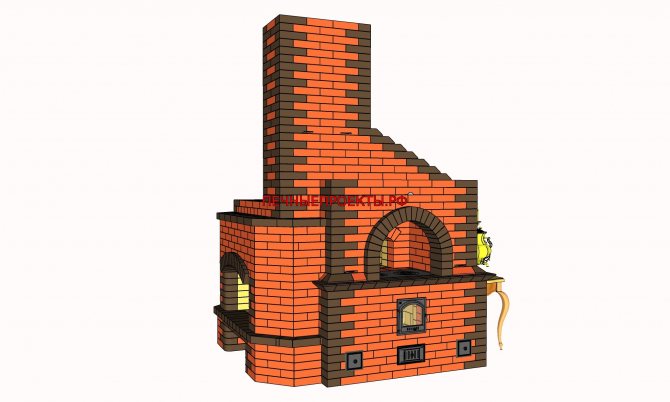

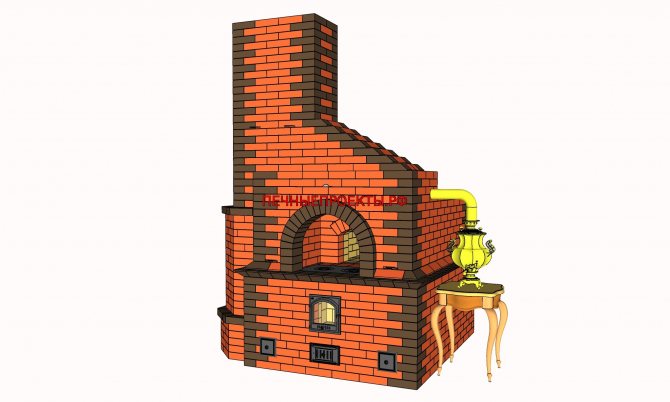

- Dimensions: 2190mm * 2170mm
- Heated room: up to 80 sq.m.
- Cooking chamber dimensions: 890mm * 510mm
- Number of bricks: 2700pcs
Russian stove 8
Russian teplushka Igor Kuznetsov. Fireplace and bed.
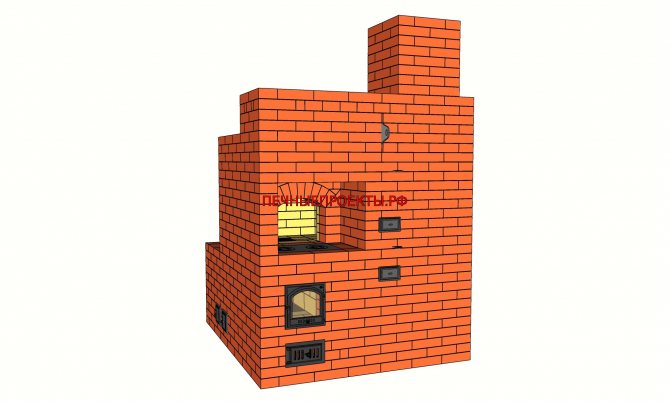

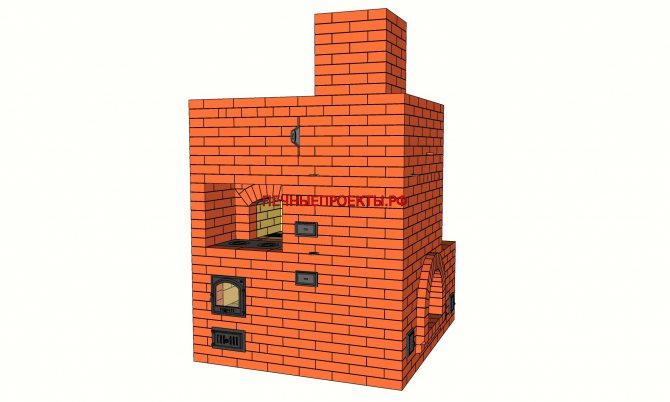

- Dimensions: 1910mm * 1660mm
- Heated room: up to 65 sq.m.
- Number of bricks: 1700pcs
Russian stove 9
Barbecue oven
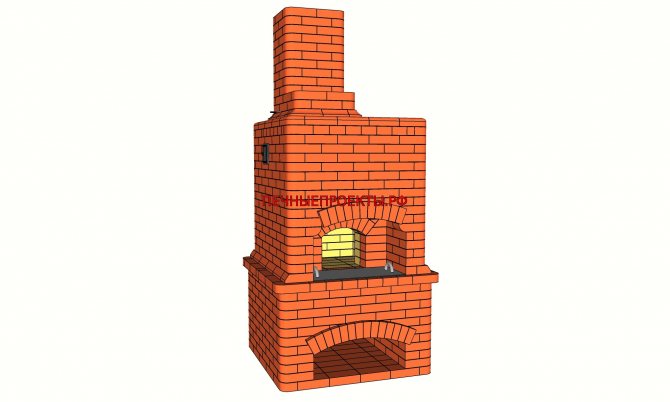

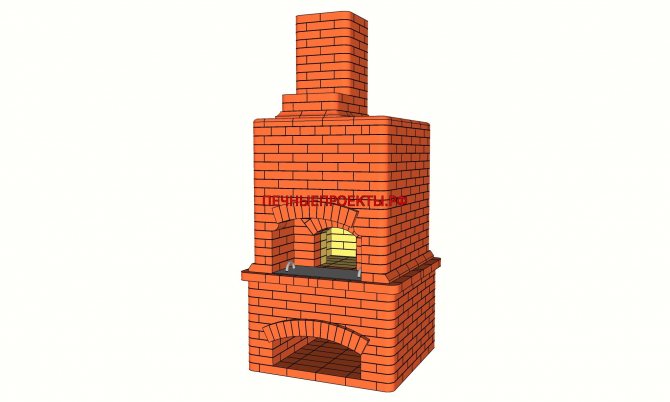

- Dimensions: 1280mm * 1280mm
- Heated room: up to 30 sq.m.
- Number of bricks: 1150pcs
- Gas flow diagram: SDG
Russian stove 10
With ducts and fireplace
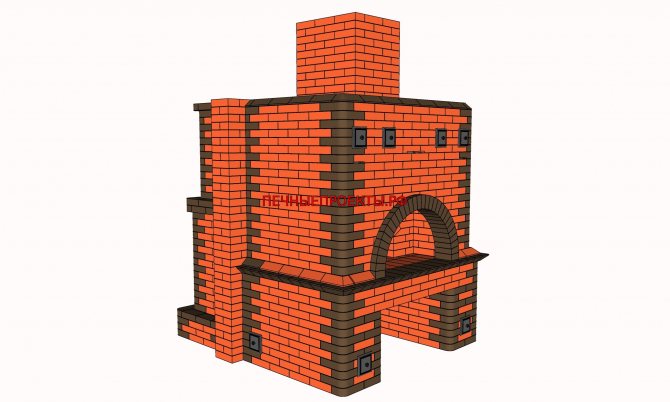

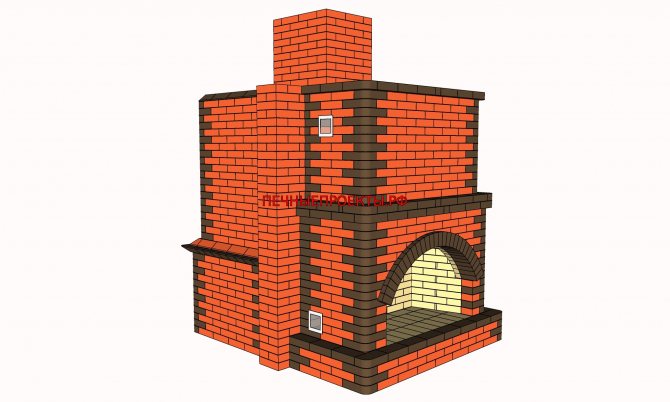

- Dimensions: 2420mm * 2040mm
- Heated room: 60 sq.m.
- Number of bricks: 3380pcs
- Operating modes: Fireplace, Russian stove, heating stove mode by channels
- Gas flow diagram: channel
Thanks to the Russian stove, you can cook food, heat the room, and heal (on a couch).
Russian-style stove on the street
This option has recently been preferred by the owners of country houses instead of a barbecue complex or in addition to it.
Before you build a Russian stove with your own hands on the street, you should prepare the base. It must be durable reinforced concrete so that the structure does not collapse and sag.
For the construction, red brick and chamotte are used for the vault. The stove is closed with a valve; a separate pipe runs along the back wall to the cauldron from the stove. The chimney can be made of facing bricks. The smoke is removed through stainless steel pipes wrapped in basalt cardboard in order to avoid strong heating of the cladding.
Before you build a Russian stove on the street, you should prepare:
- red bricks 800 pcs.;
- fireclay - 70 pcs.
It is better to cover the tabletop with tiles, the apron is made of brick, it is good to equip such a stove with a damper with a thermometer.
It is advisable to equip a stove structure or complex under a canopy or in a gazebo, since materials quickly deteriorate in the open air.

